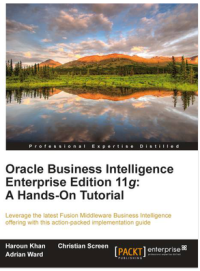About
Since a few months, a new book has appeared in the Oracle Business Intelligence landscape. This is good news for the Oracle BI community because it gives us a new middle of communication and discovery.
The book provides a more comprehensive approach that articles or blogs and gives a privileged and direct access with the authors.
We want to have all writers tips and we get them (The notes are really well placed in the book).
This book takes a global approach and describes most aspects of the Oracle BI Suite.
The goal is to provide the readers with a practical guide on the fundamentals. All chapters ends up with further readings and links in order to continue and improve your skills.
You will find the following Chapters:
- Architecture
- Installation
- System Management
- Reporting Database Concept
- BI repository development
- Presentation Catalog Features
- Dashboard and Analytics
- Agent and Action Framework
- BI Publisher
- Dashboard Style Customization
- Performance Improvement
- Change Management
- Usage Tracking
- Olap Integration (Essbase and Oracle OLAP)
- Oracle BI planet
The book is available in many format (Kindle, Online, Pdf, …) and with a forum to support it. You will find all the sample database objects and data from the public repository.
Apart from the last chapter that uses the Linux Oracle Vm machine, all other chapters use the following technology: Windows for the Operating System and MySql for the Database.
The reader should be familiar with facts, dimensions, and star schemas. The Chapter 7 “Reporting Database” gives still some information on the subject.
The reader must also know how to configure a DSN or hosts file. The writers will not go into detail on setting this up. Skip and ragged hierarchies are not addressed considered as a too advanced subject.
The architecture, installation and concept takes a big part of the book. The book “get to the heart of the OBIEE system” in its middle (47% on my kindle).
I would still like to see a navigation that sets a filter. I prefer a snowflake model than a star one. I prefer also to hear about byte that number of rows. I found that the logging level is not enough detailed. I don’t know if a beginner can understand that statistics are database table statistics. Cardinality is addressed in the data model but could be more explained as it is how OBIEE discovers the fact table and then the query path. I can’t also agree when I read that “Oracle BI and Oracle BI Publisher both have strengths and weaknesses”. Oracle BI has of course only strengths.
This remarks and wishes are really details in an ocean of information because the book is full of topics such as:
- Oracle’s Application Integration Architecture (AIA)
- Oracle Container for Java (OC4J)
- Oracle BI Enterprise Deployment Guide (EDG) with High Availibility
- Lightweight Directory Access Protocol (LDAP) server
- Security Assertion Markup Language (SAML) 2.0
- SSO
- Security administration
- eXtensible Access Control Markup Language (XACML)
- Metadata
- The 12 database rules
- Web (HTTP) tier proxy
- Wlst and jmx
- Dynamic HyperText Markup Language (DHTML)
You get also tips such as:
- how you can implement a folder navigation for a project of 50,000 potential users.
- how you can order your dimensions and facts
- how you can automate the creation of BI server repository objects with XUDML
- why the metadata table of the BI Publisher Scheduler starts with QRTZ
This book was written by three authors:
- Haroun Khan
- Christian Screen
- Adrian Ward
I don’t have the privilege to know Haroun Khan as he doesn’t maintain a blog presence. It has knowledge of OBIEE back to nQuire and like me try to avoid to be far away of his home.
Christian Screen is the Oracle ACE blogger behind the Art of Business Intelligence (ArtOfBi.com) website.
Adrian is for me the most well known. It has working in Siebel Analytics (Old Name of OBI) back in 2001.
I have discover that it can be strong with this children as I don’t kwnow one that can stay quiet. Adrian Blog was one of my first blog subscription.
They have choosen three reviewers:
- Daan Bakboord
- Kevin McGinley
- Ramke Ramakrishnan
Daan Bakboord is a Nederlands BI Consultant with a big background on the Oracle BI Application suite. He has a lot of tehcnical knowledge as wel as a big heart. I will never be enough thankful for its support during my difficult time.
Kevin McGinley has worked in BI/Data Warehousing in both IT and consulting since 1997. He was a guest speaker on the last BI Forum.
Ramke Ramakrishnan doesn’t seems to have an internet presence. It has 15 years of experience in the BI and EPM field and was recognized as Deputy CTO.
Written a book is not an easy exercise (felicitations!) and I have to admit that I had a pleasant time reading it. I didn’t have followed all exercises. I trust the reviewers and in case of problem of simply question you can always write a ticket on their forum.
The book is available in many format (Kindle, Online, Pdf, …) on the PacktPub Website.
Happy learning, Happy reading !

